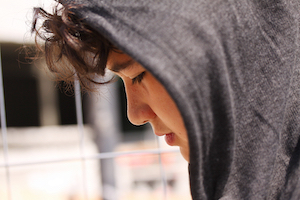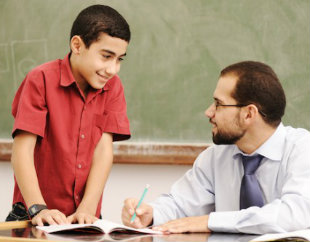Bringing More Empathy into Your Classroom
By Katelyn Oellerich, Ed.S.
 What is Empathy?
What is Empathy?
Have you ever shared a vulnerable moment with someone about something that’s been tough for you, just to be met with an “at least” or “but look at the bright side…”?
For me there have been many occasions, but one that stands out is when I was having a particularly tough week at work. I shared my frustrations of feeling down about my week with a relative. My relative responded with, “Well, at least you have the summer to look forward to.”
This conversation took place in February. I was livid. I not only felt unheard, but also as though my frustration and general feeling of exhaustion were not worthy of concern because “I had the summers off.”
Soon after this conversation I was introduced to the Empathy Video by Brené Brown. The examples given of responses that people seem to think are helpful but really are not were so relatable to my experiences that I wanted to share the video with everyone I knew.
I restrained myself, but I have since sought to bring this need for an empathic response into my work with students in our schools. The ideas and experiences I share here might be helpful to you as well.
Justin’s Story
If you’ve ever supported a student with challenging behaviors, you’re aware of how hard it can be to remain calm and consider their perspective. However, if you’re able to do this with empathy, it can be life altering for the child.
 During my first couple of years as a school psychologist I worked with a student whom we’ll call Justin. Justin was a child that showed a lot of impulsive behaviors. One day Justin ran out of his classroom and into my office.
During my first couple of years as a school psychologist I worked with a student whom we’ll call Justin. Justin was a child that showed a lot of impulsive behaviors. One day Justin ran out of his classroom and into my office.
I was not able to fully grasp his reason for doing this, but I did understand that he came to me because he didn’t feel like he was being heard by his teacher.
After close to an hour of processing in various ways, Justin’s body was calmed enough to return to the classroom. We had thought through what would happen when he returned to his room, and he was feeling good about himself.
We walked up to the room, he apologized to the teacher, and we planned to move forward. However, the teacher was still frustrated. It was written on her face, and when she heard the apology she explained to him all of the things he had missed while he was gone.
I watched as I saw his face droop and his eyes begin to dart. Then he was off. He fled the space and was now running throughout the school again.
Restorative Conversations
Justin is not an isolated student. Although his behaviors were extreme, all kids hate to disappoint us. They pick up on those micro-facial cues, they feel hurt when their wrong doings are continually discussed, and they want more than anything to feel heard and understood.
Restorative Conversations is one powerful tool I recommend to consistently incorporate empathy into classrooms and schools while also positively impacting behavior.
Reflecting on this episode early in my professional practice, the conversation with Justin could have gone much better if it had included more restorative components.
1. A brief discussion about what had happened
Teacher: “Can you help me understand what was going on today during math? I was really surprised when you ran out of the classroom and worried when you didn’t come back for a while.”
Student: (shrugs) “I don’t know. I didn’t have my homework done and you never listen when I try to explain why I didn’t get it done. You just look mad.”
2. Understanding and empathy toward how the student felt
Teacher: “I know you have a lot going on at home, and finding time to get homework done can be a challenge. How were you feeling when you ran out of the classroom?”
Student: “I was feeling embarrassed and mad. You don’t understand.”
Teacher: “Yes, I can see that you felt embarrassed and mad. What could I do to help?”
3. What the student needed
Student: “I don’t have time when I get home to do my homework. I need to take care of my little sister and brother.”
Teacher: “Okay, what do you think about us making time during school for you to try and get more homework done? Maybe before or after school? Or, we could work together during lunch?”
Student: “Yea, maybe that could help.”
4. Who was impacted
Teacher: “Good, so it sounds like we have a plan. Now, I want you to think about how running out of the room impacts others. How do you think that affected me and your classmates?”
Student: “It distracted from their learning and made you feel worried.”
5. What needed to be done to fix the situation
Teacher: “Yes, you’re right. What do you think needs to be done next time instead?”
Student: “I could talk to you and make a plan to do my homework.”
Teacher: “That sounds like a great idea. Now, let’s get back to the class. I know you’re enjoying Dog Boy and we are independent reading right now.”
In addition, if the teacher had been in the middle of a lesson and was not able to take part in such a conversation at that time, a plan should have been made to re-visit the situation with the student while starting by welcoming them back to the class. For example:
“Welcome back, Justin. Right now everyone in the class is learning about multiplication. You and I will take some time to talk about what happened more privately during lunch. Go take your seat and you can get out your math book.”
For more information about Restorative Conversations, this toolkit at WestEd’s SEL Center provides teachers, counselors and school leaders with strategies and resources for engaging in this kind of dialogue with students – including techniques for laying the groundwork and useful starter questions and phrases.
Building Empathy
Just like adults, our students will respond better when we offer an empathic response. They will feel more heard and understood which often leads to better academic outcomes as well.
 Our students will pick up and show more empathy the more that we model and teach empathy within the classroom.
Our students will pick up and show more empathy the more that we model and teach empathy within the classroom.
Justin’s case of course is meant to be used in as-needed situations. Empathy can be taught and incorporated daily and/or through structured lesson plans as well. Teaching empathy in these ways can help to build your classroom community and set up an expectation of kindness and understanding.
More Tips and Resources
►Mental Health Check-In
Have students write their name on the back of a post it and stick it on a sign that has columns that indicate how they are feeling that day (e.g.; I’m Great, I’m Okay, I’m Meh, I’m struggling and would like a check in, I’m in a dark place). For students who are feeling low, ask them to join you for a few minutes after class or during lunch to check in.
For more information about the mental health check-in visit, see this Good Morning America story.
►Lesson Plans on Empathy
Utilize Books. Here is an inclusive list of options: https://www.commonsensemedia.org/lists/books-that-teach-empathy
Discuss YouTube videos (e.g.; https://nobully.org/initiative/burger-king/ )
Discussion questions for books or videos might include:
• What example(s) of empathy did you notice?
• What examples did you notice caused harm?
• Have you ever experienced harm in this way (e.g.; someone ignoring, someone laughing, someone being mean)? How did it make you feel?
• Have you ever experienced genuine empathy from someone? How did it make you feel?
• How do you think we can better incorporate empathy into our school?
Note: These types of discussions can be challenging as they involve some vulnerability. Therefore, the lesson might be more impactful if done in pairs or small groups, or if students are given an opportunity to write and reflect.
Katelyn Oellerich, Ed.S. is a school psychologist in Mineral Point, WI in her 8th year and has had experience in both urban and rural settings. She has presented research focused on Mindfulness and Planning and Organization Skills and has additional training in social-emotional learning, art therapy, trauma sensitive schools, Families and Schools Together, and gender inclusive practices. Katelyn enjoys supporting student engagement by empowering relationships at school.

































